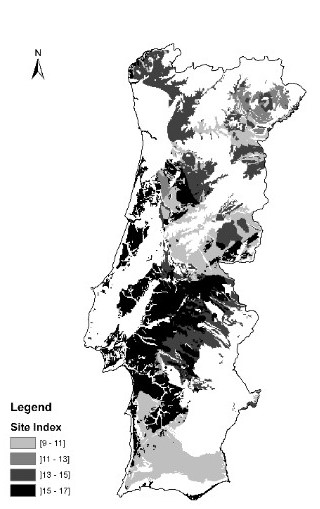
In recent decades, new cork oak plantation areas have been established in Portugal, not only in the traditional areas of distribution of the species but also in the northern parts. Historical records show that the species was formerly present here, and climatic thresholds suggest a possible occurrence. Cork oak site productivity, assessed through site index, was modelled in relation to soil and climate variables. The models were developed to estimate and map the site index value along the cork oak potential distribution area in Portugal.
As per the Portuguese National Forest Inventory, 719,9 mil ha is occupied by cork oak forests/agroforests (ICNF 2019). However, historical records show this distribution is smaller than the country's potencial.
Site productivity estimation is important for the establishment of forest management plans, definition of forest policy measures and the development of growth models. Therefore, different site productivity evaluation methods may be used, such as site index. It refers to the dominant height of a stand at a certian reference age, which for cork oak is 80 years of age.
- Water availability and soil water-holding capacity is correlated with site index.
- Site index is correlated with climate variables, namely evaporation and frost.
- Site index is correlated with soil characteristics such as lithology, soil texture, soil depth, thickness of the A horizon and soil classification.
- The estimated values of site index for Portugal range between 9.5 and 16.8 m, with an average value of 13.4 m.
- Results confirm the potential distribution of cork oak in coastal regions. They also suggest the existence of a considerable area, located both North and South of the Tagus river, where site index values of medium (]13;15]) to high (]15;17]) productivity classes may be expected.
While developing a forest management plan:
- Consider the site climate and soil characteristics;
- Consider soil prospecting across the site, supervised by a cork oak forest management expert;
- Use the soil information to delimit areas with homogeneous soil characteristics;
- Identify areas not suitable for cork oak plantation and consider alternative species, e.g. avoid terrain depressions and temporary waterline areas where waterlogging conditions and heavy soil texture conditions may persist;
- Use a model proposed by Paulo et al. (2015) to estimate the site index for areas with homogeneous site conditions;
- Use previously estimated values to simulate expected stand growth and production using an appropriate model (e.g.: SUBER 5.0 model. Available here).
The variability of the estimated values within the site index map (Fig 2.) reflects the soil characteristics' impact on site productivity estimation. This reinforces the importance of data collection about soil characteristics while establishment new stands.
The relationship of the cork oak site index with other soil variables, which influences forest development and tree growth (pH, nutrient availability, etc.), is not provided in this work.
The estimated site index values reflect the current average climate conditions. Climate change´s impact should not be addressed exclusively using the current models.
This work focused on tree growth for the quantification of site productivity. Despite the importance of this variable, wood is not the main product sought while managing the Montado stands; rather it is non-wood forest products, especially cork. Future work considering site productivity in terms of cork production are currently under development.
Cork growth and quality distribution needs to be further researched through the establishment of long-term experimental sites along its distribution area, namely in the central and northern coastal areas of the country.
Joana Amaral Paulo, joanaap@isa.ulisboa.pt
Further information
Paulo, J. A., Faias, S., Gomes, A. A., Palma, J., Tomé, J., Tomé, M. 2015. Predicting site index from climate and soil variables for cork oak (Quercus suber L.) stands in Portugal. New Forests 46 (2): 293-307. http://dx.doi.org/10.1007/s11056-014-9462-4
ICNF. 2019. Inventário Florestal Nacional Portugal Continental IFN6, 2015. Relatório final. ICNF, Lisboa. http://www2.icnf.pt/portal/florestas/ifn/ifn6
SUBER 5.0 model: http://www.isa.ulisboa.pt/cef/forchange/fctools/pt/PlataformasIMfLOR_/Povoamento/SUBER
Joana Amaral Paulo

Site index predicted values within the distribution area of cork oak in Portugal (Paulo et al 2015)
